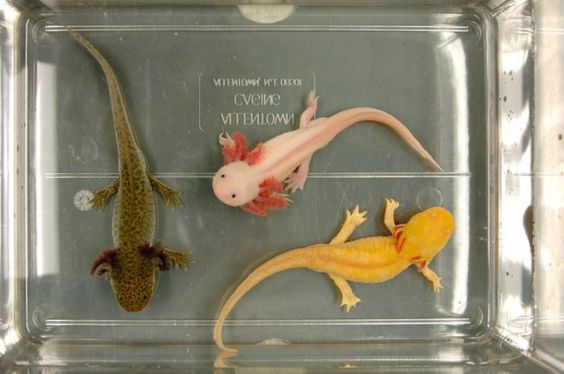Do you know that the axolotl can come in a variety of different colors? In this blog post, we will take a look at some of the most exotic colors, morphs, and types of Axolotl. The axolotl is a fascinating creature with an amazing ability to regenerate lost body parts. They come in a variety of shapes and sizes and can be found in both salt and freshwater.
Axolotl can be easily kept in an aquarium as a pet reptile, so it is loved by many. So let’s look at some of the coolest types of axolotl morphs out there!
Origin of Axolotl Morph
The axolotl originates from Mexico and was first discovered by a man named Dr. Waterhouse in 1864. They belong to the salamander family and there are two types of axolotls, the Mexican and the tiger. The tiger has a black body with thin white stripes while the Mexican axolotl has a white body with darker stripes.
Are Axolotl Endangered Species?
The axolotl is an endangered species and is currently on the IUCN Red List. The main reasons for their decline are habitat loss and water pollution. Other reasons for this include illegal capturing and hunting.
The axolotl is one of the most popular pet amphibians in the world! With such a great variety of colors. They are bred as pets in Europe, America, and Japan. Axolotls can be kept indoors or outdoors depending on the temperature of your climate.
When axolotls breed, they can produce a variety of different morphs. This is because the embryos can absorb the DNA of their parents. So when you have two genetically different axolotls breed, you can get some interesting offspring!
Axolotls are born with the ability to change their color. This means that they can be various colors such as white, black, or brown depending on what environment they live in and how much sunlight there is around them.
Here are some of the most exotic colors and morphs of the axolotl.
The top 17 Axolotl Colors are Listed as Follows
The only morph that doesn’t have subspecies is the Mexican axolotl, however, the various color variations make it hard to believe. According to some, there are over 20 morphs of axolotl costing around $40 to $1,500.
Color / Type Availability Price Rank
| Color / Type | Availability | Rank |
| Black Melanoid | Common | 8 |
| Chimera | Very Rare | 11 |
| Enigma | Rare | 15 |
| Copper | Uncommon | 6 |
| Firefly | Rare | 14 |
| Golden Albino | Common | 2 |
| Green Fluorescent Protein | Uncommon | 13 |
| Heavily-Marked Melanoid | Uncommon | 12 |
| Lavender | Rare | 7 |
| Leucistic | Common | 1 |
| Mosaic | Very Rare | 5 |
| Piebald | Rare | 4 |
| Speckled Leucistic | Common | 10 |
| White Albino | Common | 9 |
| Wild | Common | 3 |
Genetics of Axolotl
To fully comprehend the different hues, we must first understand genetics, genes, and cells. Axolotls have three distinct types of pigment cells or “chromatophores,” each producing a unique color.
Axolotls acquire their color due to two separate genes, one from each parent. Each gene has three parts that code for the three types of chromatophores (see table above). The alleles are known as sections. The combination of alleles determines the number of each chromatophore type produced in the axolotl’s skin.
| Cell Type | Pigment | Color |
| Melanophore | Eumelanin | Blackish-brown |
| Xanthophore | Carotenoids and Pteridines | Yellow and red |
| Iridophore | Crystalized Purines | Shiny, reflective iridescence |
Melanophores are pigmented cells that provide color to the skin. An allelic variant of albino individual codes for severely reduced levels of melanophores in the epidermis. Melanophores give the skin a blackish-brown hue, so they’re lacking it in this person and appear rather white.
The black axolotl, for example, is a melanoid species. Melanoid axolotls have alleles that generate more melanophores, resulting in a black variety.
Axolotls that have only one albino allele and one non-albino allele will not be albinos. To display the albino coloration, requires two copies of the albino gene. This makes obtaining particular colors more difficult than others, as well as determining how uncommon certain morphs are.
Many morphs begin with a genetic change in the typical color alleles, resulting in a unique hue or pattern. This is also true of snakes, and the Ball Python Morphs is a great example. Color morphing from one mutant individual requires meticulous selective breeding and lots of perseverance.
Today, as the popularity of this pet increases, new variants are still being discovered.
1. Albino Axolotl
Albino axolotl results from two albino parents mating. They have a white body with red eyes. white albino have red gills, like other albinos. Their gills are slightly different from normal axolotls because they have black spots on them, making them stand out more than usual.
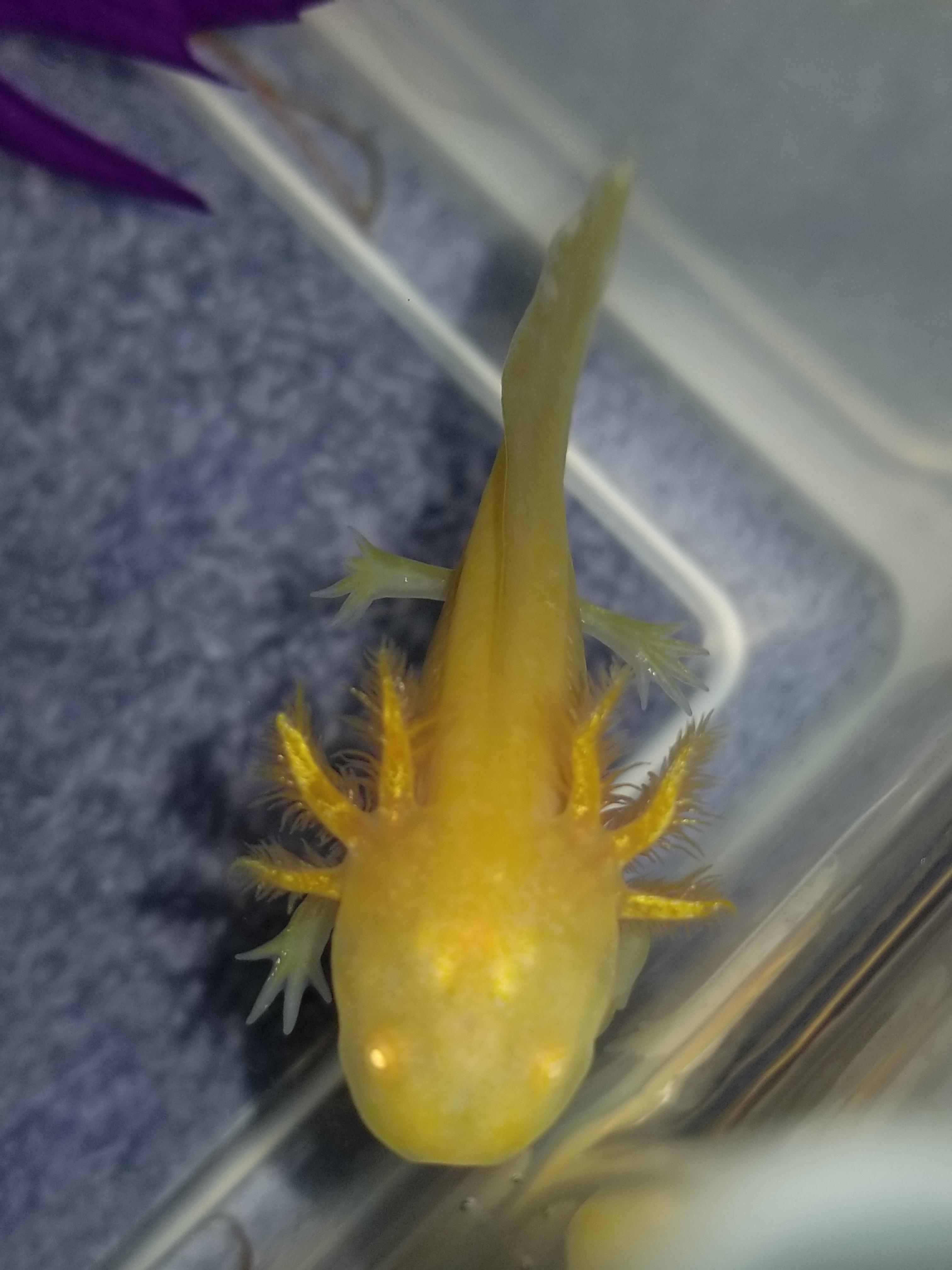
Albino axolotl is one of the most popular types because it looks different from regular axolotls.
Young white albinos are almost see-through because they have no pigment in their skin.
Theyophores on them are not developed enough to give standard skin color. They can take up to two years before they become entirely white with red eyes.
White albinos are similar to leucistic axolotls in that they lack melanin, but the difference is that leucistic axolotls still have some pigment.
White albinos are sensitive to light, so it is essential to keep them in a tank covered with something dark like cloth. This will help protect their eyes from getting sunburned.
2. Melanoid Axolotl
It was first discovered in 1961. They have a dark brown skin color with black eyes and gills. Melanoid axolotl is the result of two albino parents mating.
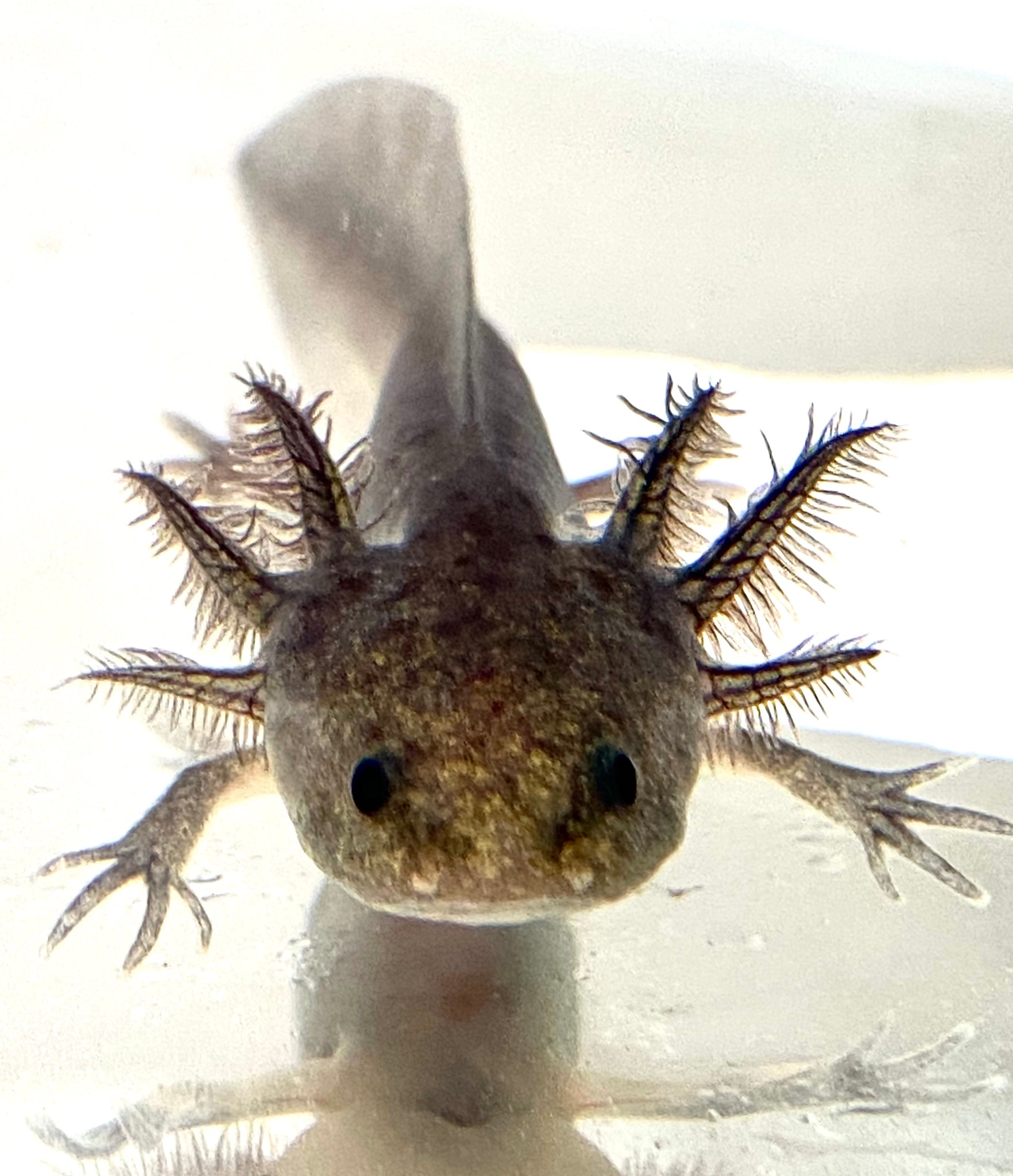
Melanoid axolotl is not as famous as the albino axolotl, but they are still a popular type. This is because they are easier to take care of than albino axolotls.
Melanoides have more melanophores than regular axolotls, so they have a darker skin color. They have fewer iridophores, so they don’t have a metallic sheen.
Their color ranges from black to dark brown. But some of them can be lighter in color than others because there are different types of melanoid axolotl.
Melanoid axolotl can change their color based on substrate and lighting. So if you have a darker substrate, they will turn darker as well! Change is not permanent.
3. Copper Axolotl
The copper axolotl has copper-colored skin with black eyes and gills. Their skin is a result of the presence of pterin, which causes them to turn pink or red when exposed to sunlight.
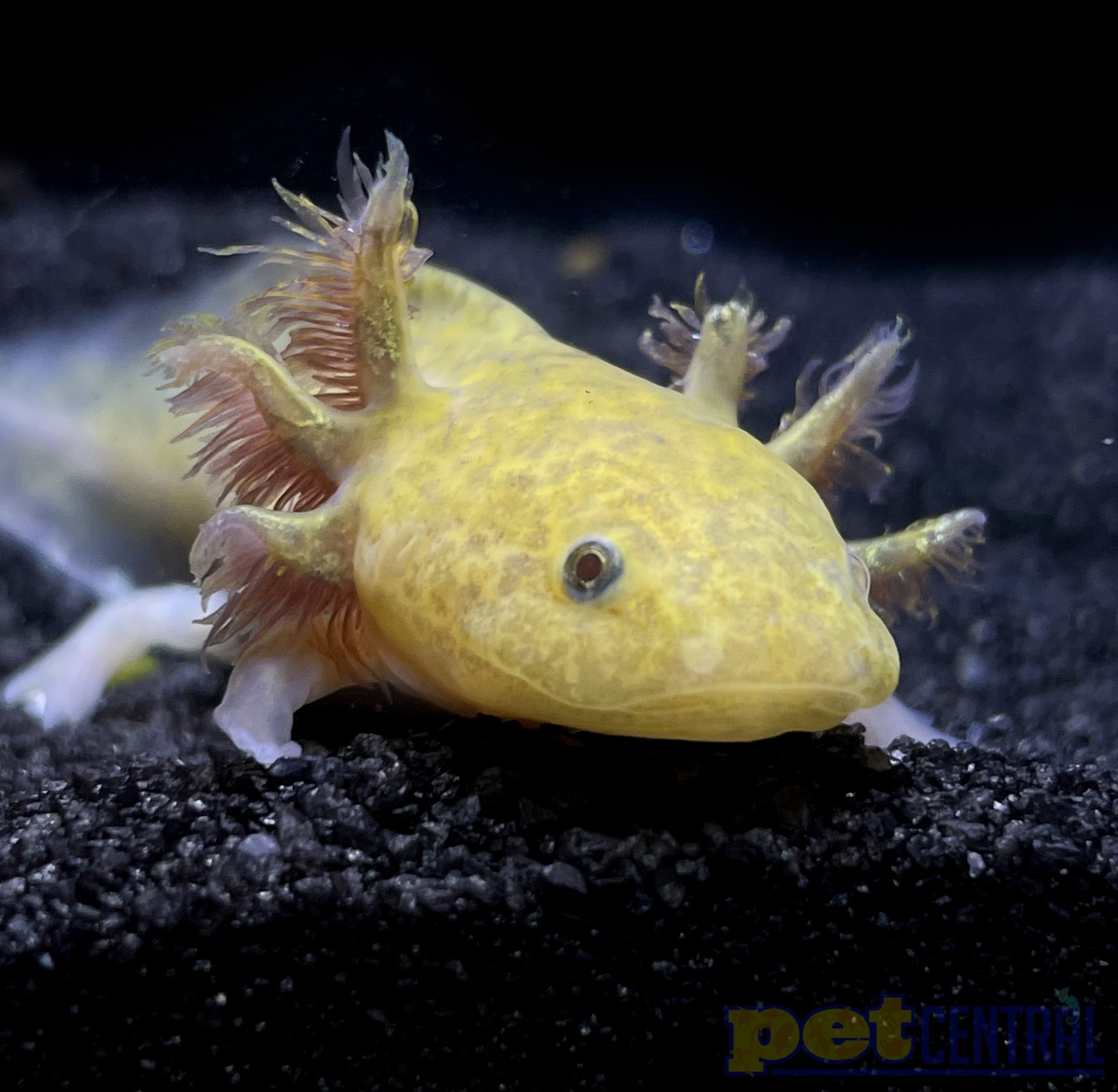
The copper axolotl is not as famous as other types because they have a more limited color range than others. They can only be either brownish-red in color or copper-colored. Their cute face and sand-like color is why they are popular.
Copper axolotls have a cream-colored underbelly, this makes them more attractive to predators, so it’s best to keep them somewhere safe, like an aquarium with plenty of hiding spots!
It is thought that copper axolotls are the result of two albino parents mating, but this has yet to be confirmed by science. Copper axolotls do not produce melanin, and their eyes may appear pink if they look directly into sunlight or other bright lights for long periods. They also don’t shed their skin like normal axolotls do when molting; instead, all that happens during moltings is that new cells replace old ones.
Copper axolotl also tends to eat less food than other types because their metabolism is slower due to being cold-blooded animals (which means that it takes longer for them to digest what they eat). Copper axolotls cannot change colors as some other types can; however, if you keep them outside, the sun will cause their skin tone to become darker over
4. Golden Albino Axolotl
Golden Albino Axolotl is a pure white peach in color with red eyes. They are the result of two albinos mating, but they have a mutation that causes them to lack melanin, which makes them appear more yellow than pink.
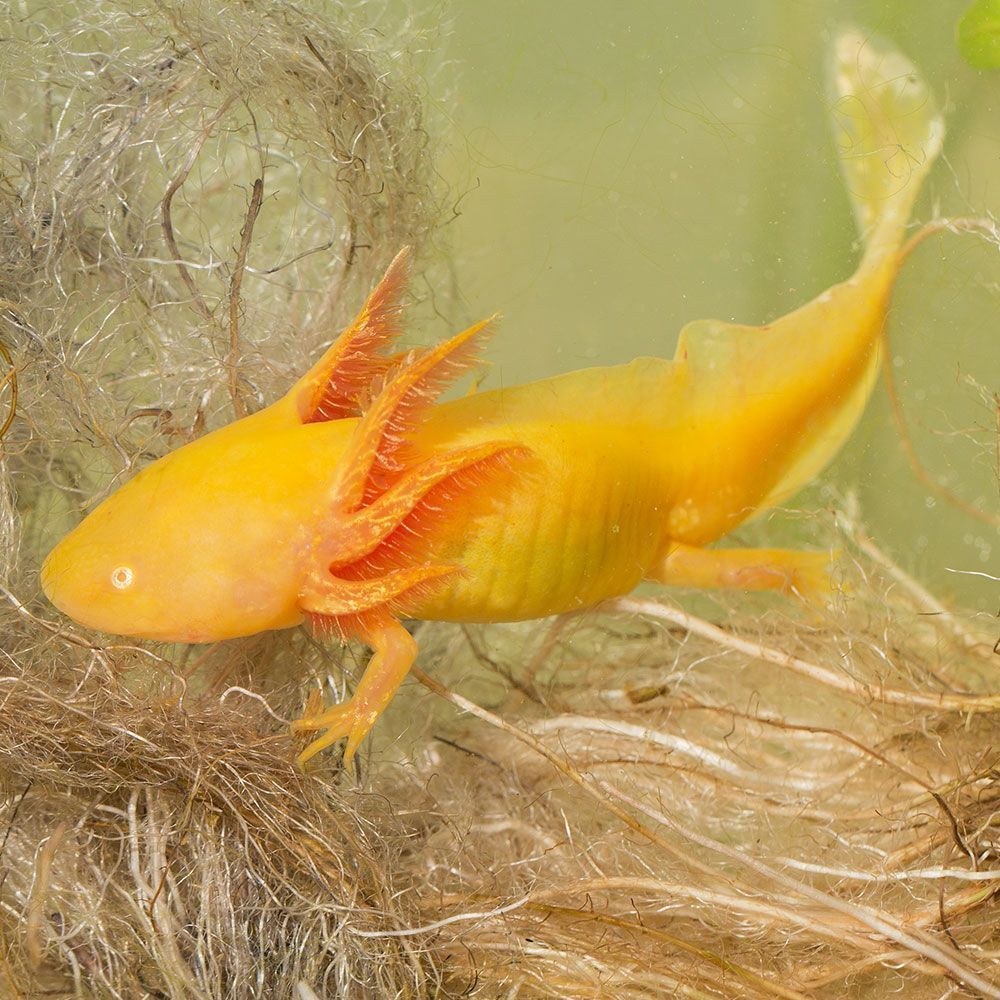
Golden Albino Axolotl is one of the most beautiful types because of its bright and vibrant skin! Golden Albinos can change colors depending on how much light hits their bodies; however, this doesn’t often happen since it’s hard for sunlight or any other kind of lighting to penetrate through water easily.
The golden color comes from an enzyme known as tyrosinase which breaks down pigment called eumelanin into smasoes called pheomelanin (which gives these axolotls ash hue).
5. Leucistic Axolotls (white)
Leucistics are translucent white and have pink eyes. They are the result of two albinos mating, but they lack both melanin and pterin.
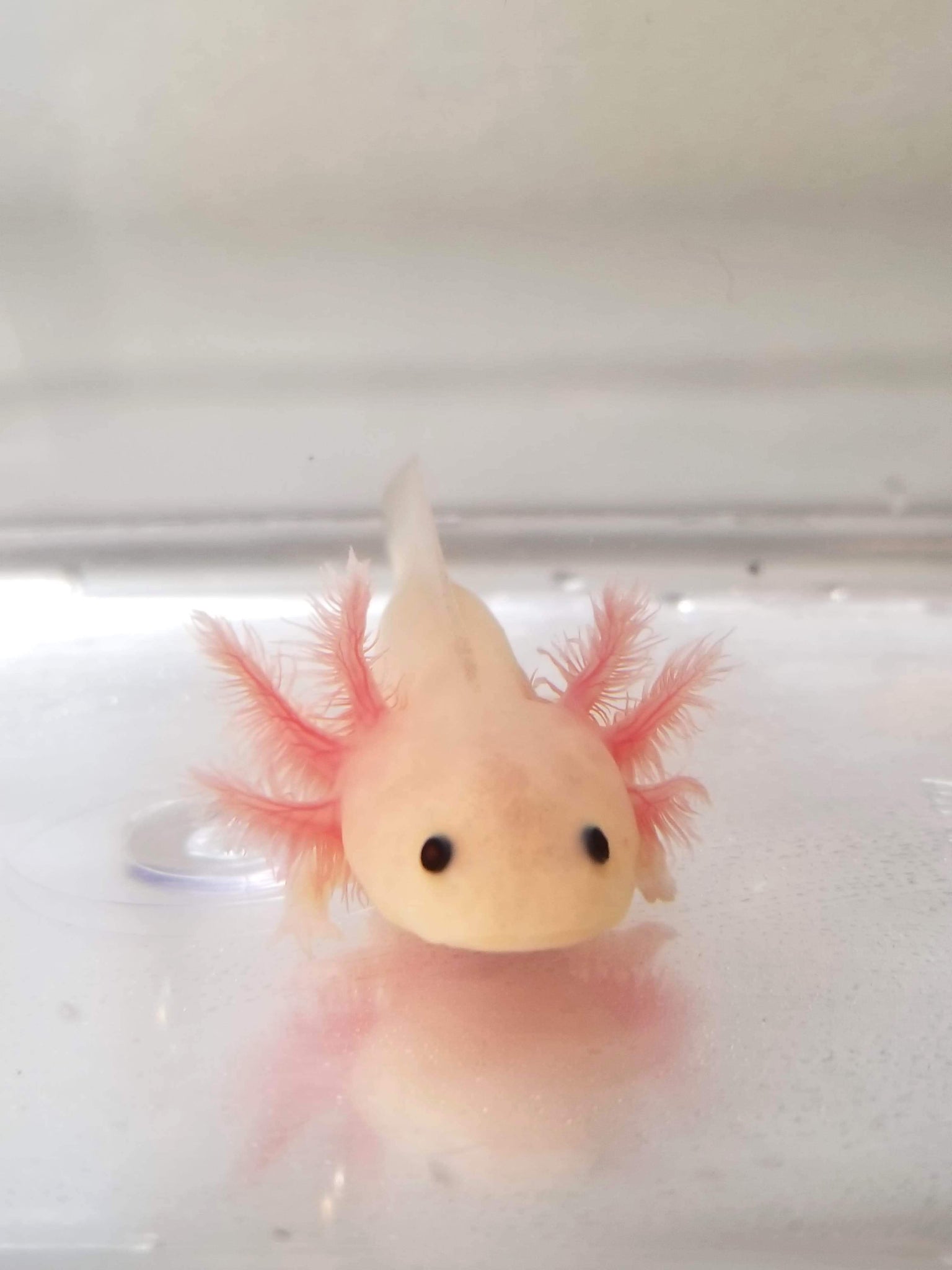
Leucistic axolotls are very rare because they cannot produce offspring if they mate with other leucistic or any other type of axolotl for that matter; this is why their population is slowly decreasing.
Leucistic can change colors depending on how much light hits their bodies; however, this doesn’t often happen since it’s hard for sunlight or any other kind of lighting to penetrate through water easily.
Leucism is caused by a genetic mutation that affects the pigment cells in their skin. Leucistic axolotls can be translucent or opaque, and they have pink eyes because their iridophores are almost nonexistent!
They also tend to eat less food than other types because they do not produce melanin (which is what gives most animals color) so this means that leucistic axolotl cannot change colors as some others can; however, if you keep them outside then the sun will cause them to darken over time which could result in death due to heatstroke since these animals don’t have any natural protection against UV rays from sunlight or artificial lighting sources such as lamps/lights at home.
Leucistic tend to live longer too – up to five years old if they’re kept well. They are also very easy going so it’s not hard
Leucistic do require more care than other axolotls because of their lack of pigment; this means that these animals need special food pellets and supplements as well! Although you can feed them live worms or brine shrimp too,
6. Erythristic Axolotls (red)
Erythristic axolotls are a result of a leucistic axolotl mating with another erythristic axolotl, and they are the most common type of axolotl. They range in color from light pink to dark red, and their eyes can be blue, green, or brown.
Erythristics can change colors depending on how much light hits their bodies; however, this doesn’t happen often since it’s hard for sunlight or any other kind of lighting to penetrate through water easily.
Erythristics get their name from the word “erythro” which means red. These axolotls have a lot of pheomelanin in their skin cells, which is why they come in so many different shades. Their eyes can be blue, green, or brown depending on how much melanin they have (which is what gives most animals color) and if there isn’t enough then erythristics will look like albinos.
Erythristic axolotls are the easiest types to care for because of their lack of pigment – this means that these animals need special food pellets and supplements as well! Although you can feed them live worms or brine shrimp too, it’s best not to overfeed any kind of axolotl since they’re carnivores with very small stomachs which means they’ll get sick easily from overeating (and die).
7. Axanthic Axolotl (yellow)
Axanthic axolotl is the result of a leucistic axolotl mating with another axanthic axolotl, and they are the rarest type of axolotl. They range in color from light yellow to dark gold, and their eyes can be blue or green.
Axanthics can change colors depending on how much light hits their bodies; however, this doesn’t happen often since it’s hard for sunlight or any other kind of lighting to penetrate through water easily.
Axanthic means yellow so these axolotls come in all different shades of that color! Just like erythristic, they have a lot of pheomelanin in their skin cells which is why they come in such bright colors. Their eyes can be blue, green or brown depending on how much melanin they have (which is what gives most animals color) and if there isn’t enough then axanthic will look like albinos.
8. Albinotic Axolotl (pale pink)
Albinotic Axolotl s are the result of a leucistic axolotl mating with another albinotic axolotl, and they’re one of the most common types. They range in color from pale pink to white, and their eyes can be blue or green.
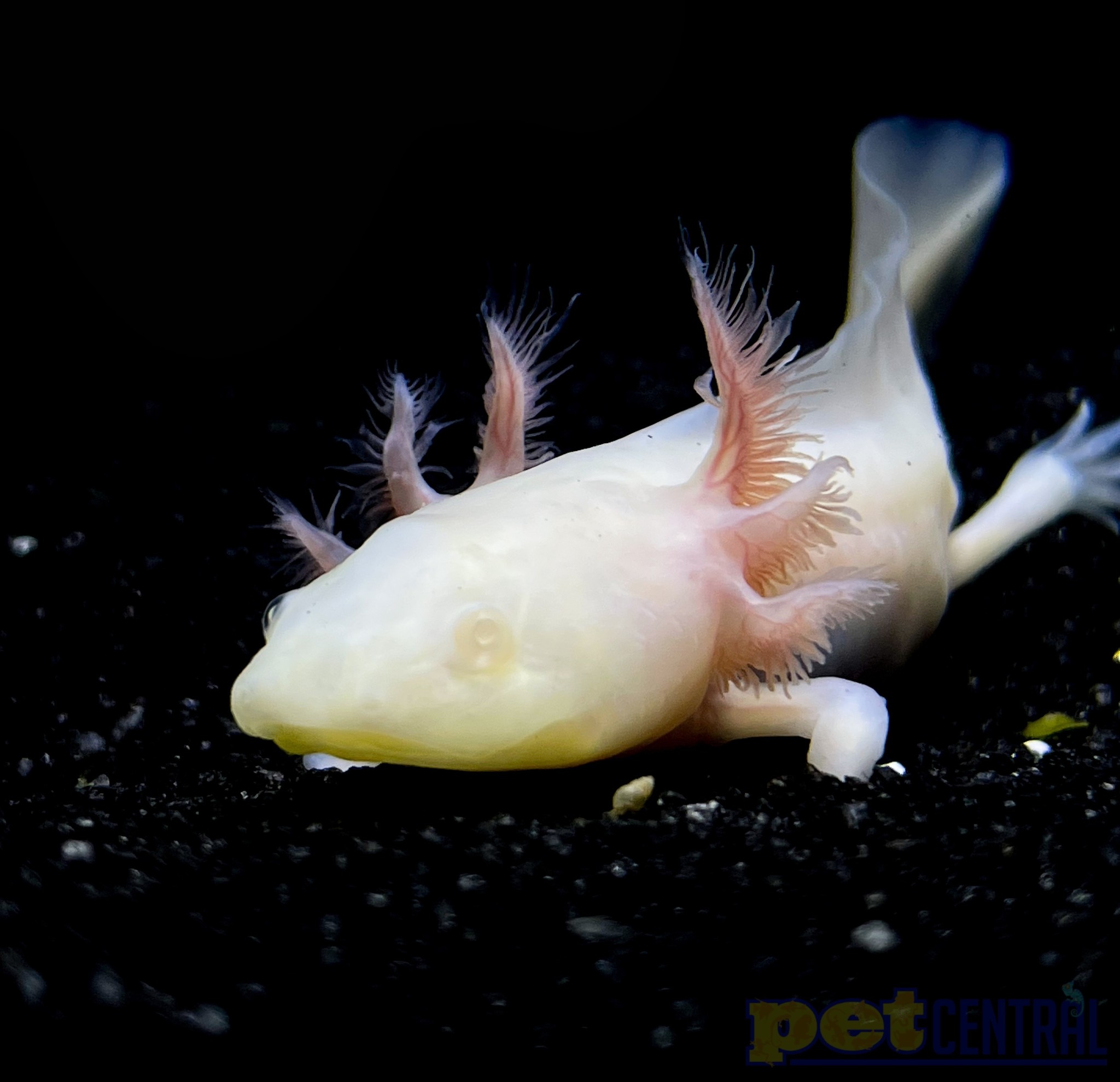
Albinotic can change colors depending on how much light hits their bodies. White skin cells absorb all wavelengths so these animals will look like snowflakes when placed under light sources such as lamps/lights at home. Albinotic means “white” which is why they come in different shades: albino means no pigment while blanched means pale pinkish tones.
10. Wild Type Axolotl
The wild type axolotl is dark grayish brown with black flecks and their eyes are red or orange. They have a lot of melanin in their skin cells, which is why they come in so many different shades. Their eyes can be blue, green, or brown depending on how much melanin they have (which is what gives most animals color) and if there aren’t enough then wild types will look like albinos.
Wild-type axolotls are the oldest axolotl pet and were first discovered in the wild. They’re the most common type of axolotl and can be found in many different colors such as dark grayish brown, black, or even albino. These animals have a lot of melanin in their skin cells, which is why they come in so many different shades.
11 . Green fluorescent protein axolotls
Green fluorescent protein axolotl glows like a lightbulb under blacklight! These animals are the result of a leucistic axolotl mating with another green fluorescent protein axolotl, and they’re one of the rarest types. They range in color from yellow to green, and their eyes can be blue or green.
GFPs gene was originally found in jellyfish and transferred over to axolotls which makes them glow brightly under black lights.
The morph was created in Max Planck Institute of developmental biology and is a very popular type of axolotl to own as a pet.
GFPs come in many different colors such as yellow, green, blue or even red! Just like erythristics, they have a lot of pheomelanin in their skin cells which is why they come in such bright colors. Their eyes can be blue, green or brown depending on how much melanin they have (which is what gives most animals color) and if there isn’t enough then GFPs will look like albinos.
12 . Mosaic Axolotl
The mosaic axolotl is the result of two different types of axolotl mating, and they’re one of the most common types. They range in color from yellow to green, and their eyes can be blue or green.
Mosaics are named for their unique coloring: they have patches of dark melanin cells scattered all over their bodies. These animals cannot be bred with other morphs, and can only be produced through mating two different types of axolotls.
13 . Lavender
The lavender axolotl has a light pink color with dark spots. These animals cannot be bred with other morphs, and can only be produced through mating two different types of axolotls. Their body is covered with gray spots and they have a pale pink color.
The lavender morph is only found in the United states and Canada.
14 . Firefly
Fireflies are the artificially created axolotl morph. They are the result of Embryonic graphing and you can not find them easily in the wild.
Fireflies were created in a lab at the University of Tennessee health science center by Lloyd storhi.
They are called Fireflies because only a small part of their body lights up under blacklight.
Fireflies come in many different colors such as yellow, green, blue, or even red! Just like erythristics, they have a lot of pheomelanin in their skin cells which is why they come in such bright colors. Their eyes can be blue, green, or brown depending on how much melanin they have.
15 . Enigma
This enigma morph is dark gray with a white belly, golden eyes, and red gills. They are the result of a leucistic axolotl mating with another enigma morph, and they’re one of the rarest types.
The enigma morph was first discovered in 2009 by a breeder in the United States, and since then these animals have been rising in popularity as pets.
The enigma morph is one of the most popular types of axolotl to own as a pet. They range in color from yellow to green, and their eyes can be blue or green.
Enigmas are named for their unique coloring: they have patches of dark melanin cells all over their bodies.
16 . Chimera
chimera is the rarest breed of axolotl and was developed due to an accidental mating between two different types of axolotl.
The chimera morphs are the result of accidental breeding during the research work to find the enigma breed. The researchers were trying to produce a pure black axolotl by crossing wild type and melanoid, but instead, they developed this new breed which had features from both breeds in it.
The chimera is the rarest axolotl morph and has features of both melanoid and wild-type axolotls. They have an almost fully black body with white spots on their head, back legs, and tail which give them their unique look.
chimera is the rarest type of axolotl and you can find them in a few selective countries. They are the result of a leucistic axolotl mating with another chimera morph, and they’re one of the most prized types of axolotl to own as a pet.
17 . Speckled Leucistic
Leucistic axolotls are white with a few small patches of color, and their eyes can be blue or green.
The speckled leucistic axolotl is a type of leucistic mutation where you get blotches of black melanin cells all over the body. This gives them a unique look and makes them one of the most popular types of axolotl to own as a pet.
FAQ
Lavender (silver Dalmatian). These morphs of Axolotl are very rare and are typically are entirely lavender or light gray colored. The lavender color is contrasted by the silver to dark gray spots speckling the entire body of Lavender axolotl.
It is thought that there are now over 20 different Axolotl coat colors kept as pets. Many different color variants have been produced through breeding, some of which are rarer and more sought-after.
It’s true. Axolotls can alter the color of their skin and gills, as Tank Origin discovered. They’ll adapt to a variety of external and internal stimuli, including their genetics, diet, health status, and level of activity.
Conclusion
Though there are quite a few types and morphs of Axolotl but for a beginner, all of this can be overwhelming. Whatever morph you want to keep as a pet, you must ensure that its safety, health, diet, and care is your priority. If you are looking to keep axolotl as a pet then it will be more difficult for everyone.

